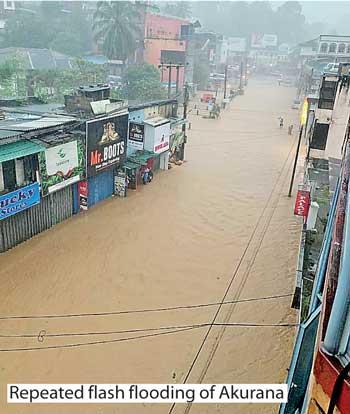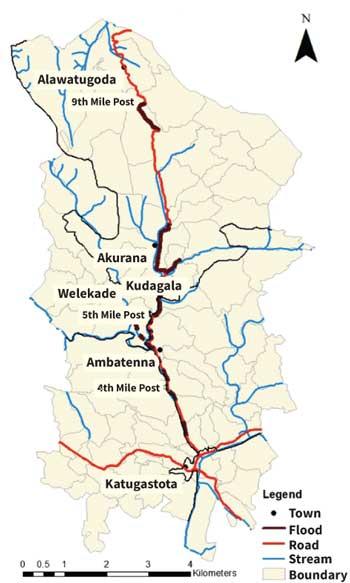Reply To:
Name - Reply Comment
There is a lack of transparency and engagement of concerned experts, advocates, and others. There are shortfalls in following regulations by officials. Monitoring and enforcement of regulations by officials are poor
 For the past two decades, the Pinga Oya has overflown onto the Kandy-Jaffna A9 highway along Akurana and adjacent towns. After two major floods in 2022 and 2023 which overtopped the A9 road by 11 feet, the 2024 flood season has already commenced on the 8 th of November 2024 with a flood that reached 5 feet.
For the past two decades, the Pinga Oya has overflown onto the Kandy-Jaffna A9 highway along Akurana and adjacent towns. After two major floods in 2022 and 2023 which overtopped the A9 road by 11 feet, the 2024 flood season has already commenced on the 8 th of November 2024 with a flood that reached 5 feet.
The Engineers’ Association, Akurana (EAA) has been deeply concerned about the repeated flash flooding of Akurana from the Pinga Oya tributaries. Here we set out the position of our scientists and engineers who are deeply engaged on the causes of these flash floods so as to address some misinformation that stands in the way of an effective response.
The primary causes of flooding are:
 The Polgolla Reservoir Does Not Cause the Flash Floods.
The Polgolla Reservoir Does Not Cause the Flash Floods.
Some attribute the flood in Akurana as due to the impact of the Polgolla barrage. No one has provided any scientific evidence to support this claim. Instead, proponents recount anecdotes which they interpret as causal rather than coincidental. The arguments as to why Polgolla could play a minor role are -
The top barrage gates of Polgolla are about 10 meters below the road level of Akurana. Thus, closing the gates cannot cause backfilling of water. If the Polgolla barrage caused backfilling, then the Katugastota and Ambatenna areas and areas at lower elevations like Akurana should also be flooding. This is not the case!
Some attribute the flood in Akurana as due to the impact of the Polgolla barrage. No one has provided any scientific evidence to support this claim. Instead, proponents recount anecdotes which they interpret as causal rather than coincidental
 In all flash flooding events, water in the river in Akurana flows rapidly towards Katugastota.There was no flood reported in the first 10 years after the barrage was constructed in the 1980s and very few floods were recorded in the 1990s.Some argue that the silt has built up in the reservoir leading silt upstream. There would be an impact due to silt accumulation, however the dominant presence of construction debris, mud and household waste accumulation on the riverbed has not been addressed.
In all flash flooding events, water in the river in Akurana flows rapidly towards Katugastota.There was no flood reported in the first 10 years after the barrage was constructed in the 1980s and very few floods were recorded in the 1990s.Some argue that the silt has built up in the reservoir leading silt upstream. There would be an impact due to silt accumulation, however the dominant presence of construction debris, mud and household waste accumulation on the riverbed has not been addressed.
Some speculate that Climate Change may be a cause. There is no evidence for that based on rainfall records. Rainfall intensity has not increased in the last two decades.
Why have the Floods not been Mitigated?
Effective flood mitigation policies are unfortunately held back due to misinformation, misdirection, neglect of science and engineering, and even a lack of common sense. At present,
The public are unable to contribute to the governance of the river and its catchment.
There is a lack of transparency and engagement of concerned experts, advocates, and others. There are shortfalls in following regulations by officials. Monitoring and enforcement of regulations by officials are poor.
Rigorous engineering and scientific analysis do not inform remedies and policies.
Recently Proposed Mitigation Steps
Here we set out some on the mitigation steps for developing effective flood mitigation and river restoration. After the major floods of December 2022, the mitigation steps announced by the government officials led by the District Secretary were -
1. To remove silt from the riverbed.
2. To remove some structures on the river.
Widen the narrow (Mangos watte) bridge near the Akurana sign board at the 9th km post.
Widen the bridge going to Neeralla near the 10th km post.
3. Setting up an alert system for the Polgolla barrage to open its barrage gates at the time of flooding in Akurana. Of these,
The river silting has been carried out in a few flooded areas in early 2023.
The central span of the Mangos Watte Bridge has been broken.
However, even with these mitigation steps, the flood levels were higher in November 2023 with a daily rainfall of 120mm compared to December 2022 even though the daily rainfall was only 70mm.
Further, various other construction and earth dumping in the river and its margins and catchment have enhanced the causes of flooding. Excavating the river alone does not help except for a few months until the next flood.
EAA Recommends the Following Principles for Flood Mitigation
Transparency and Public Engagement
The writer is the Secretary, Engineers Association of Akurana, Convenor, Restore Pinga Oya and Principal Scientist / Engineer, Federation for Environment, Climate and Technology, Digana, Akurana, Maldives and New York (www.fect.lk and www.disaster.lk and www.climate.lk). He also served as the Former Senior Research Scientist, Columbia University Water Center and International Research Institute for Climate and Society (which has been hosted after starting an R&D program 20 years ago with the Mahaweli Authority of Sri Lanka).